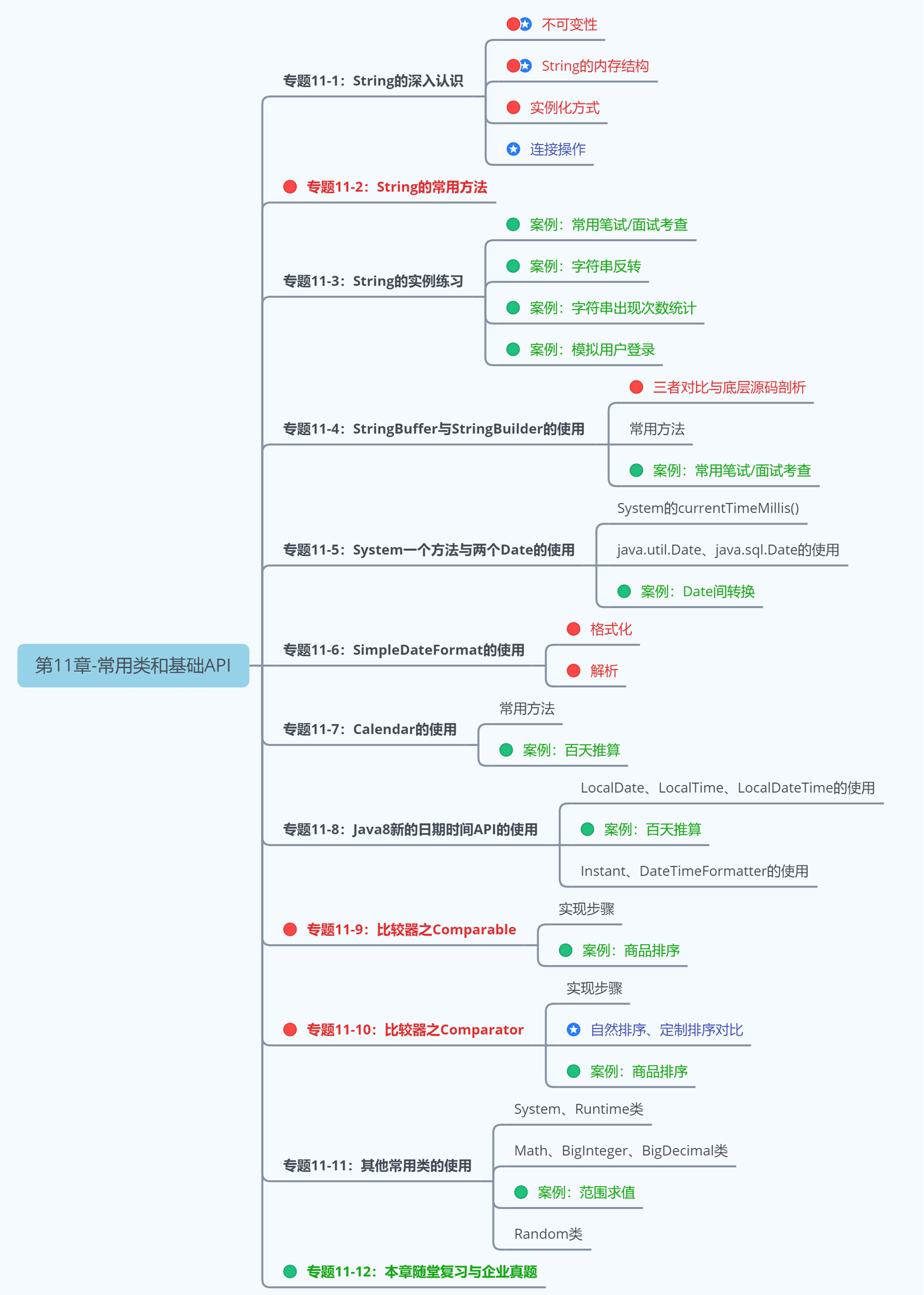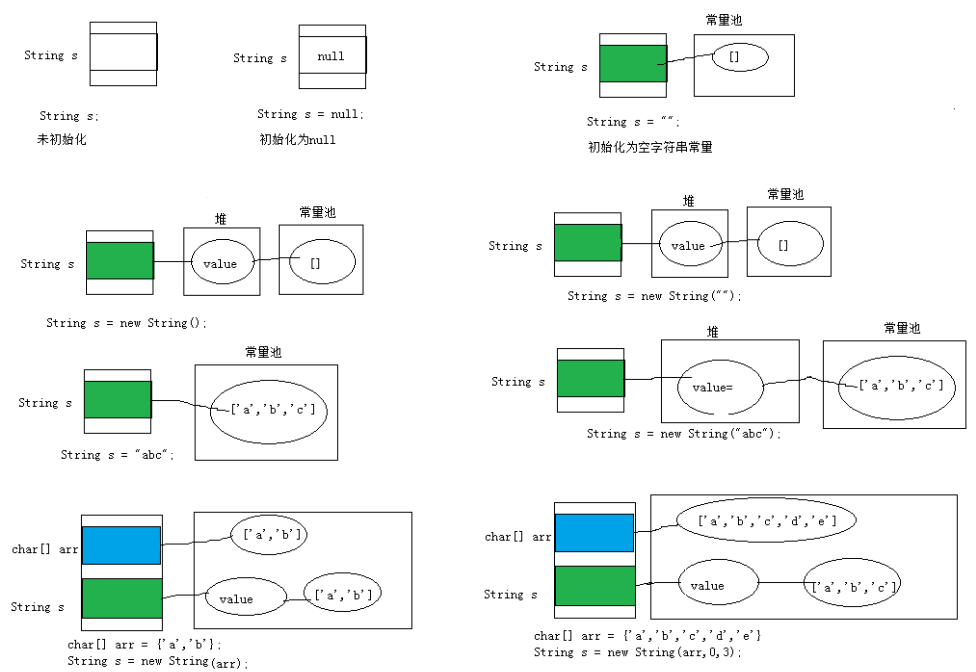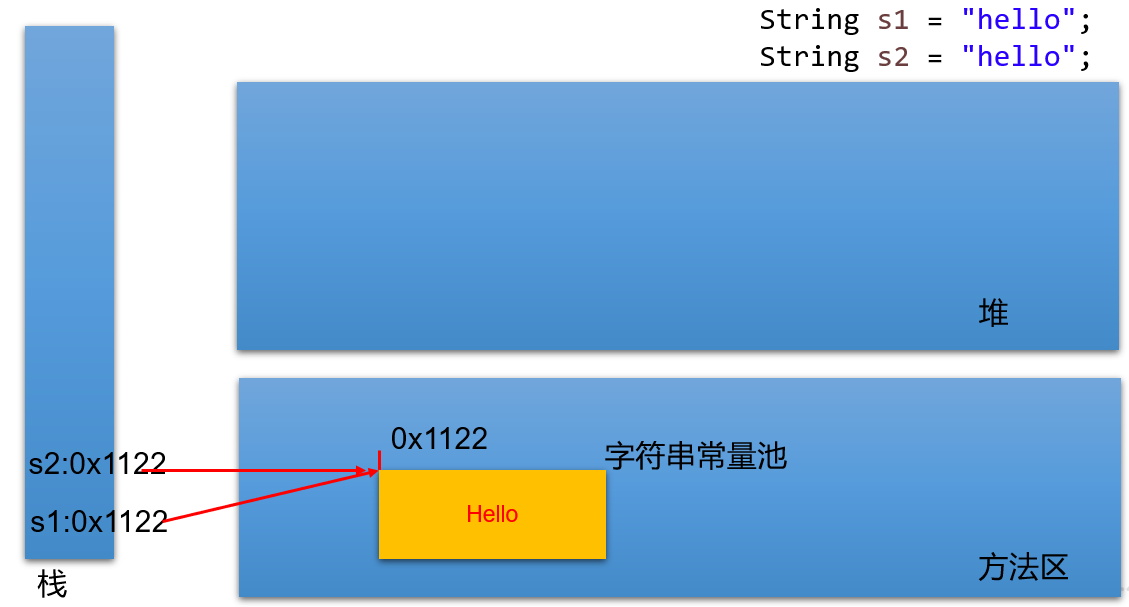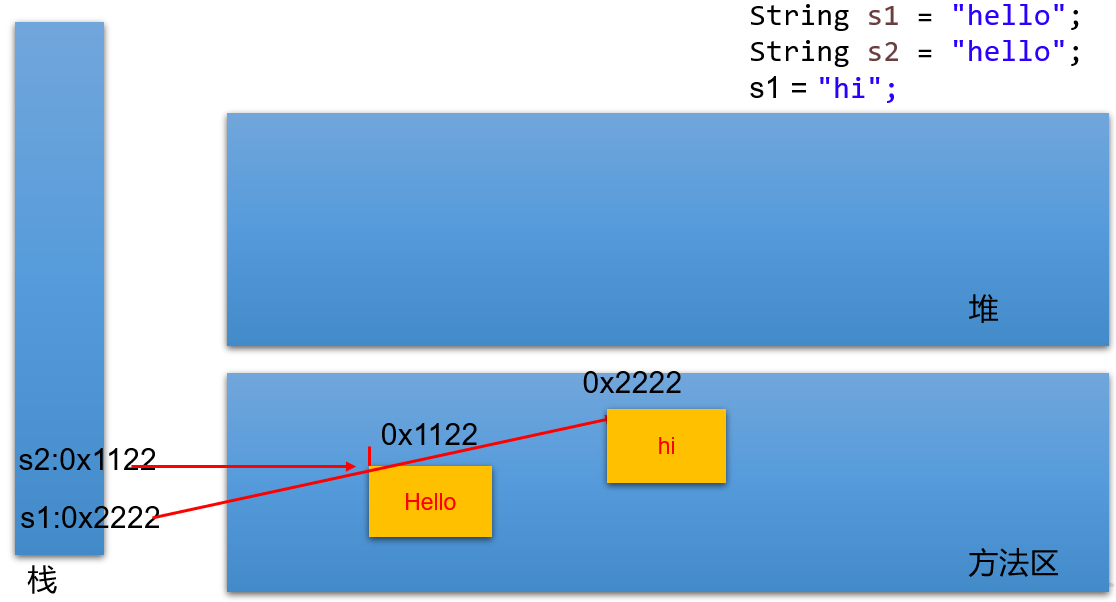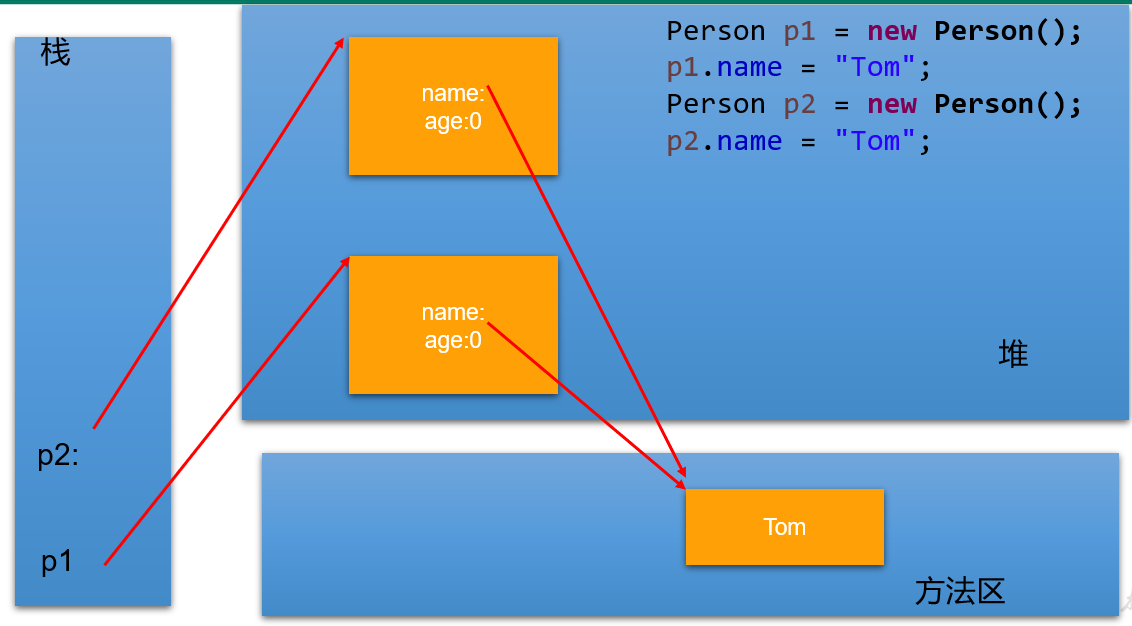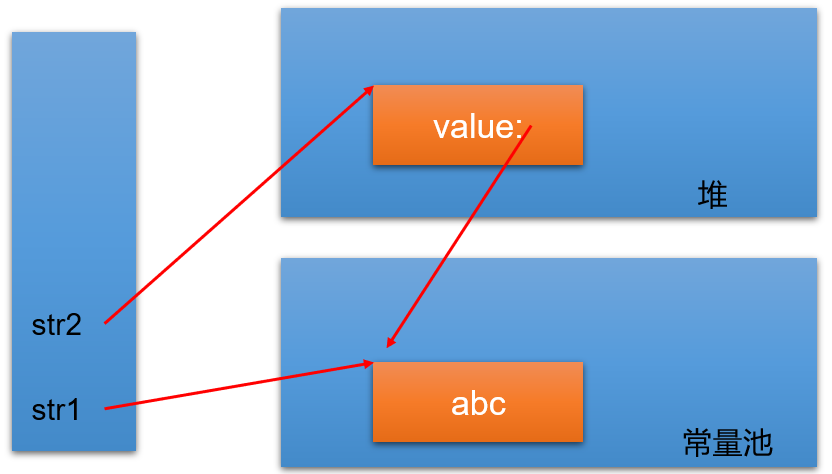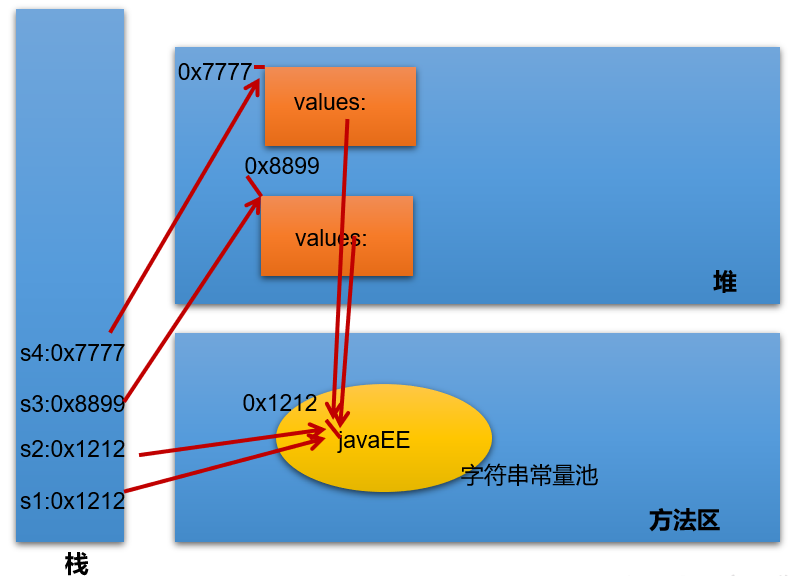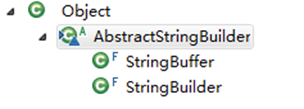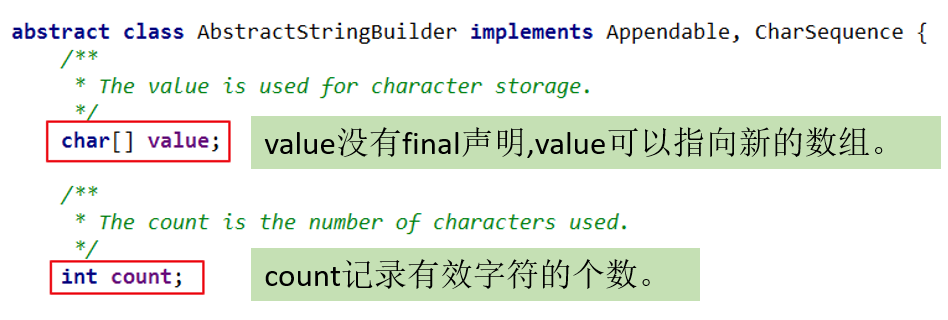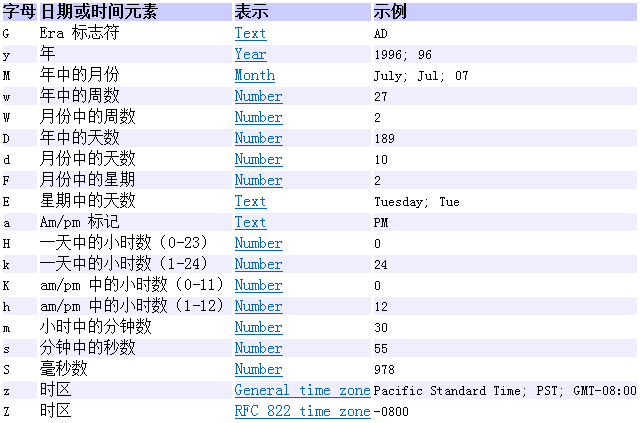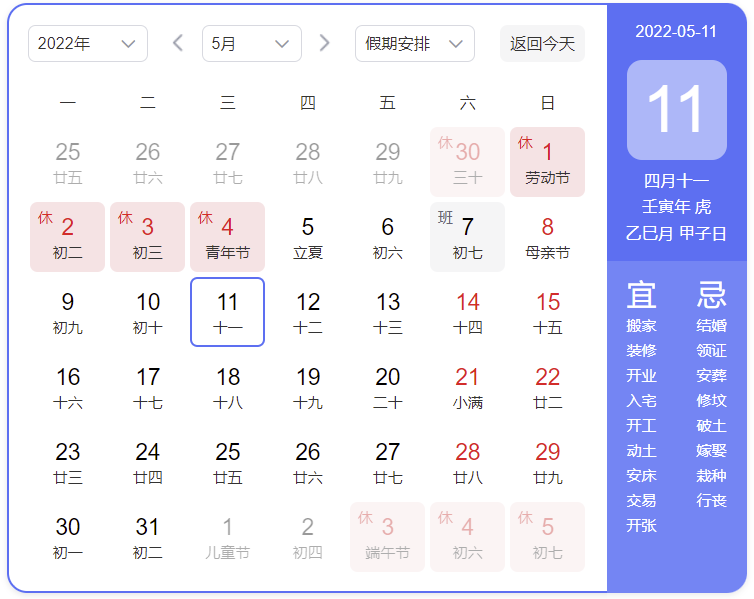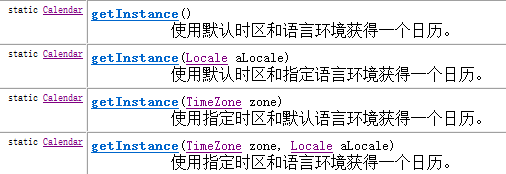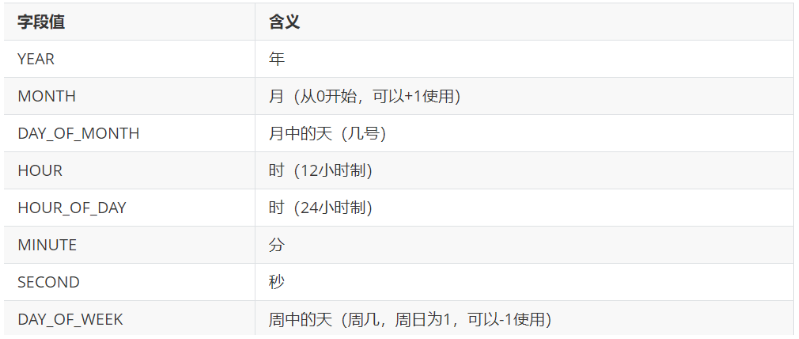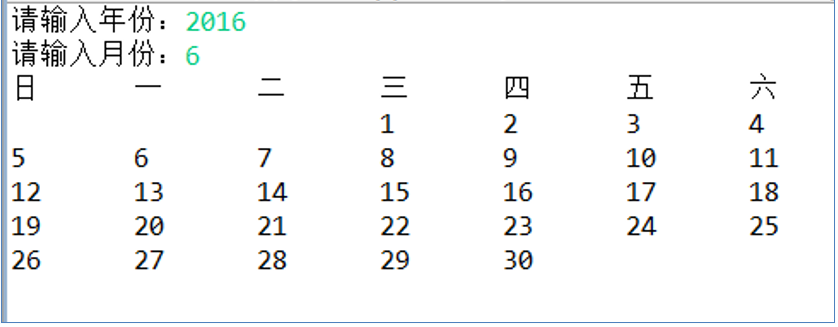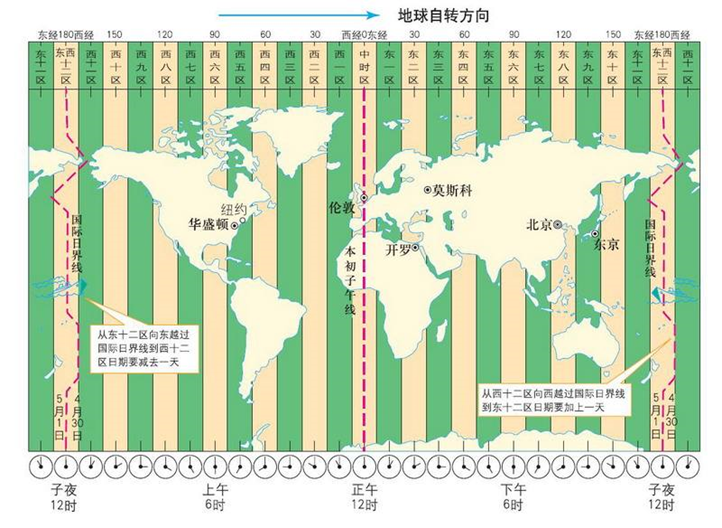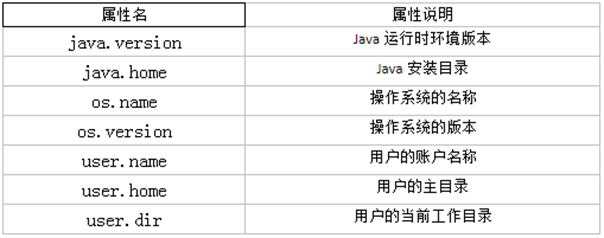第11章_常用类和基础API 本章专题与脉络 1. 字符串相关类之不可变字符序列:String 1.1 String的特性
java.lang.String 类代表字符串。Java程序中所有的字符串文字(例如"hello" )都可以看作是实现此类的实例。
字符串是常量,用双引号引起来表示。它们的值在创建之后不能更改。
字符串String类型本身是final声明的,意味着我们不能继承String。
String对象的字符内容是存储在一个字符数组value[]中的。"abc" 等效于 char[] data={'h','e','l','l','o'}。
1 2 3 4 5 6 7 8 9 public final class String implements java .io.Serializable, Comparable<String>, CharSequence { private final char value[]; private int hash;
private意味着外面无法直接获取字符数组,而且String没有提供value的get和set方法。
final意味着字符数组的引用不可改变,而且String也没有提供方法来修改value数组某个元素值
因此字符串的字符数组内容也不可变的,即String代表着不可变的字符序列。即,一旦对字符串进行修改,就会产生新对象。
JDK9只有,底层使用byte[]数组。
1 2 3 4 5 6 7 8 public final class String implements java .io.Serializable, Comparable<String>, CharSequence { @Stable private final byte [] value; }
Java 语言提供对字符串串联符号(”+”)以及将其他对象转换为字符串的特殊支持(toString()方法)。
1.2 String的内存结构 1.2.1 概述 因为字符串对象设计为不可变,那么所以字符串有常量池来保存很多常量对象。
JDK6中,字符串常量池在方法区。JDK7开始,就移到堆空间,直到目前JDK17版本。
举例内存结构分配:
1.2.2 练习类型1:拼接 1 2 3 4 String s1 = "hello" ;String s2 = "hello" ;System.out.println(s1 == s2);
对应内存结构为:(以下内存结构以JDK6为例绘制):
进一步:
1 2 3 4 5 6 7 8 9 Person p1 = new Person ();p1.name = “Tom"; Person p2 = new Person(); p2.name = “Tom" ;System.out.println(p1.name.equals( p2.name)); System.out.println(p1.name == p2.name); System.out.println(p1.name == "Tom" );
1.2.3 练习类型2:new String str1 = “abc”; 与 String str2 = new String(“abc”);的区别?
str2 首先指向堆中的一个字符串对象,然后堆中字符串的value数组指向常量池中常量对象的value数组。
字符串常量存储在字符串常量池,目的是共享。
字符串非常量对象存储在堆中。
练习:
1 2 3 4 5 6 7 8 9 String s1 = "javaEE" ;String s2 = "javaEE" ;String s3 = new String ("javaEE" );String s4 = new String ("javaEE" );System.out.println(s1 == s2); System.out.println(s1 == s3); System.out.println(s1 == s4); System.out.println(s3 == s4);
练习:String str2 = new String(“hello”); 在内存中创建了几个对象?
1.2.4 练习类型3:intern()
说明:在字符串常量池中创建了一个字面量为”a”的字符串。
说明:实际上原来的“a”字符串对象已经丢弃了,现在在堆空间中产生了一个字符串s1+”b”(也就是”ab”)。如果多次执行这些改变串内容的操作,会导致大量副本字符串对象存留在内存中,降低效率。如果这样的操作放到循环中,会极大影响程序的性能。
说明:直接在字符串常量池中创建一个字面量为”ab”的字符串。
说明:s3指向字符串常量池中已经创建的”ab”的字符串。
说明:堆空间的s1对象在调用intern()之后,会将常量池中已经存在的”ab”字符串赋值给s4。
练习:
1 2 3 4 5 6 7 8 9 10 11 String s1 = "hello" ;String s2 = "world" ;String s3 = "hello" + "world" ;String s4 = s1 + "world" ;String s5 = s1 + s2;String s6 = (s1 + s2).intern();System.out.println(s3 == s4); System.out.println(s3 == s5); System.out.println(s4 == s5); System.out.println(s3 == s6);
结论:
(1)常量+常量:结果是常量池。且常量池中不会存在相同内容的常量。
(2)常量与变量 或 变量与变量:结果在堆中
(3)拼接后调用intern方法:返回值在常量池中
练习:
1 2 3 4 5 6 7 8 9 10 11 12 13 14 15 16 17 18 19 20 21 22 23 24 25 26 27 28 29 30 31 32 33 34 35 36 37 38 39 40 41 42 @Test public void test01 () { String s1 = "hello" ; String s2 = "world" ; String s3 = "helloworld" ; String s4 = s1 + "world" ; String s5 = s1 + s2; String s6 = "hello" + "world" ; System.out.println(s3 == s4); System.out.println(s3 == s5); System.out.println(s3 == s6); } @Test public void test02 () { final String s1 = "hello" ; final String s2 = "world" ; String s3 = "helloworld" ; String s4 = s1 + "world" ; String s5 = s1 + s2; String s6 = "hello" + "world" ; System.out.println(s3 == s4); System.out.println(s3 == s5); System.out.println(s3 == s6); } @Test public void test01 () { String s1 = "hello" ; String s2 = "world" ; String s3 = "helloworld" ; String s4 = (s1 + "world" ).intern(); String s5 = (s1 + s2).intern(); System.out.println(s3 == s4); System.out.println(s3 == s5); }
练习:下列程序运行的结果:
1 2 3 4 5 6 7 8 9 10 11 12 13 public class TestString { public static void main (String[] args) { String str = "hello" ; String str2 = "world" ; String str3 = "helloworld" ; String str4 = "hello" .concat("world" ); String str5 = "hello" +"world" ; System.out.println(str3 == str4); System.out.println(str3 == str5); } }
concat方法拼接,哪怕是两个常量对象拼接,结果也是在堆。
练习:下列程序运行的结果:
1 2 3 4 5 6 7 8 9 10 11 12 13 14 15 16 17 public class StringTest { String str = new String ("good" ); char [] ch = { 't' , 'e' , 's' , 't' }; public void change (String str, char ch[]) { str = "test ok" ; ch[0 ] = 'b' ; } public static void main (String[] args) { StringTest ex = new StringTest (); ex.change(ex.str, ex.ch); System.out.print(ex.str + " and " ); System.out.println(ex.ch); } }
1.3 String的常用API-1 1.3.1 构造器
public String() :初始化新创建的 String对象,以使其表示空字符序列。 String(String original): 初始化一个新创建的 String 对象,使其表示一个与参数相同的字符序列;换句话说,新创建的字符串是该参数字符串的副本。public String(char[] value) :通过当前参数中的字符数组来构造新的String。public String(char[] value,int offset, int count) :通过字符数组的一部分来构造新的String。public String(byte[] bytes) :通过使用平台的默认字符集 解码当前参数中的字节数组来构造新的String。public String(byte[] bytes,String charsetName) :通过使用指定的字符集解码当前参数中的字节数组来构造新的String。
举例:
1 2 3 4 5 6 7 8 9 10 11 12 13 14 15 16 17 18 String str = "hello" ;String str1 = new String ();String str2 = new String ("hello" );char chars[] = {'a' , 'b' , 'c' ,'d' ,'e' }; String str3 = new String (chars);String str4 = new String (chars,0 ,3 );byte bytes[] = {97 , 98 , 99 }; String str5 = new String (bytes);String str6 = new String (bytes,"GBK" );
1 2 3 4 5 6 7 8 9 10 11 public static void main (String[] args) { char [] data = {'h' ,'e' ,'l' ,'l' ,'o' ,'j' ,'a' ,'v' ,'a' }; String s1 = String.copyValueOf(data); String s2 = String.copyValueOf(data,0 ,5 ); int num = 123456 ; String s3 = String.valueOf(num); System.out.println(s1); System.out.println(s2); System.out.println(s3); }
1.3.2 String与其他结构间的转换 字符串 –> 基本数据类型、包装类:
Integer包装类的public static int parseInt(String s):可以将由“数字”字符组成的字符串转换为整型。
类似地,使用java.lang包中的Byte、Short、Long、Float、Double类调相应的类方法可以将由“数字”字符组成的字符串,转化为相应的基本数据类型。
基本数据类型、包装类 –> 字符串:
调用String类的public String valueOf(int n)可将int型转换为字符串
相应的valueOf(byte b)、valueOf(long l)、valueOf(float f)、valueOf(double d)、valueOf(boolean b)可由参数的相应类型到字符串的转换。
字符数组 –> 字符串:
String 类的构造器:String(char[]) 和 String(char[],int offset,int length) 分别用字符数组中的全部字符和部分字符创建字符串对象。
字符串 –> 字符数组:
public char[] toCharArray():将字符串中的全部字符存放在一个字符数组中的方法。
public void getChars(int srcBegin, int srcEnd, char[] dst, int dstBegin):提供了将指定索引范围内的字符串存放到数组中的方法。
字符串 –> 字节数组:(编码)
public byte[] getBytes() :使用平台的默认字符集将此 String 编码为 byte 序列,并将结果存储到一个新的 byte 数组中。
public byte[] getBytes(String charsetName) :使用指定的字符集将此 String 编码到 byte 序列,并将结果存储到新的 byte 数组。
字节数组 –> 字符串:(解码)
String(byte[]):通过使用平台的默认字符集解码指定的 byte 数组,构造一个新的 String。
String(byte[],int offset,int length) :用指定的字节数组的一部分,即从数组起始位置offset开始取length个字节构造一个字符串对象。
String(byte[], String charsetName ) 或 new String(byte[], int, int,String charsetName ):解码,按照指定的编码方式进行解码。
代码示例:
1 2 3 4 5 6 7 8 9 10 11 12 13 14 15 @Test public void test01 () throws Exception { String str = "中国" ; System.out.println(str.getBytes("ISO8859-1" ).length); System.out.println(str.getBytes("GBK" ).length); System.out.println(str.getBytes("UTF-8" ).length); System.out.println(new String (str.getBytes("ISO8859-1" ), "ISO8859-1" )); System.out.println(new String (str.getBytes("GBK" ), "GBK" )); System.out.println(new String (str.getBytes("UTF-8" ), "UTF-8" )); }
1.4 String的常用API-2 String 类包括的方法可用于检查序列的单个字符、比较字符串、搜索字符串、提取子字符串、创建字符串副本并将所有字符全部转换为大写或小写。
1.4.1 系列1:常用方法 (1)boolean isEmpty():字符串是否为空
1 2 3 4 5 6 7 8 9 10 11 12 13 14 15 16 17 18 19 20 21 22 23 24 25 26 27 28 29 30 31 32 33 34 35 36 37 38 39 40 41 42 43 44 @Test public void test01 () { Scanner input = new Scanner (System.in); String word; while (true ){ System.out.print("请输入单词:" ); word = input.nextLine(); if (word.trim().length()!=0 ){ word = word.toLowerCase(); break ; } } System.out.println(word); } @Test public void test02 () { char [] array = new char [26 *2 +10 ]; for (int i = 0 ; i < 10 ; i++) { array[i] = (char )('0' + i); } for (int i = 10 ,j=0 ; i < 10 +26 ; i++,j++) { array[i] = (char )('A' + j); } for (int i = 10 +26 ,j=0 ; i < array.length; i++,j++) { array[i] = (char )('a' + j); } String code = "" ; Random rand = new Random (); for (int i = 0 ; i < 4 ; i++) { code += array[rand.nextInt(array.length)]; } System.out.println("验证码:" + code); Scanner input = new Scanner (System.in); System.out.print("请输入验证码:" ); String inputCode = input.nextLine(); if (!code.equalsIgnoreCase(inputCode)){ System.out.println("验证码输入不正确" ); } }
1.4.2 系列2:查找 (11)boolean contains(xx):是否包含xx
1 2 3 4 5 6 7 @Test public void test01 () { String str = "尚硅谷是一家靠谱的培训机构,尚硅谷可以说是IT培训的小清华,JavaEE是尚硅谷的当家学科,尚硅谷的大数据培训是行业独角兽。尚硅谷的前端和UI专业一样独领风骚。" ; System.out.println("是否包含清华:" + str.contains("清华" )); System.out.println("培训出现的第一次下标:" + str.indexOf("培训" )); System.out.println("培训出现的最后一次下标:" + str.lastIndexOf("培训" )); }
1.4.3 系列3:字符串截取 (16)String substring(int beginIndex) :返回一个新的字符串,它是此字符串的从beginIndex开始截取到最后的一个子字符串。
1 2 3 4 5 6 7 8 9 10 11 12 13 14 15 16 17 @Test public void test01 () { String str = "helloworldjavaatguigu" ; String sub1 = str.substring(5 ); String sub2 = str.substring(5 ,10 ); System.out.println(sub1); System.out.println(sub2); } @Test public void test02 () { String fileName = "快速学习Java的秘诀.dat" ; System.out.println("文件名:" + fileName.substring(0 ,fileName.lastIndexOf("." ))); System.out.println("后缀名:" + fileName.substring(fileName.lastIndexOf("." ))); }
1.4.4 系列4:和字符/字符数组相关 (18)char charAt(index):返回[index]位置的字符
1 2 3 4 5 6 7 8 9 10 11 12 13 14 15 16 17 18 19 20 21 22 23 24 25 26 27 28 29 @Test public void test01 () { String str = "helloworldjavaatguigu" ; char [] array = str.toCharArray(); Arrays.sort(array); str = new String (array); System.out.println(str); } @Test public void test02 () { String str = "jack" ; str = Character.toUpperCase(str.charAt(0 ))+str.substring(1 ); System.out.println(str); } @Test public void test03 () { char [] data = {'h' ,'e' ,'l' ,'l' ,'o' ,'j' ,'a' ,'v' ,'a' }; String s1 = String.copyValueOf(data); String s2 = String.copyValueOf(data,0 ,5 ); int num = 123456 ; String s3 = String.valueOf(num); System.out.println(s1); System.out.println(s2); System.out.println(s3); }
1.4.5 系列5:开头与结尾 (24)boolean startsWith(xx):测试此字符串是否以指定的前缀开始
1 2 3 4 5 6 7 8 9 10 11 12 13 14 15 16 17 @Test public void test1 () { String name = "张三" ; System.out.println(name.startsWith("张" )); } @Test public void test2 () { String file = "Hello.txt" ; if (file.endsWith(".java" )){ System.out.println("Java源文件" ); }else if (file.endsWith(".class" )){ System.out.println("Java字节码文件" ); }else { System.out.println("其他文件" ); } }
1.4.6 系列6:替换 (27)String replace(char oldChar, char newChar):返回一个新的字符串,它是通过用 newChar 替换此字符串中出现的所有 oldChar 得到的。 不支持正则。
1 2 3 4 5 6 7 8 9 10 11 12 13 @Test public void test1 () { String str1 = "hello244world.java;887" ; str1 = str1.replaceAll("[^a-zA-Z]" , "" ); System.out.println(str1); String str2 = "12hello34world5java7891mysql456" ; String string = str2.replaceAll("\\d+" , "," ).replaceAll("^,|,$" , "" ); System.out.println(string); }
1.5 常见算法题目 题目1: 模拟一个trim方法,去除字符串两端的空格。
1 2 3 4 5 6 7 8 9 10 11 12 13 14 15 16 17 18 19 20 21 22 23 24 25 26 27 28 public String myTrim (String str) { if (str != null ) { int start = 0 ; int end = str.length() - 1 ; while (start < end && str.charAt(start) == ' ' ) { start++; } while (start < end && str.charAt(end) == ' ' ) { end--; } if (str.charAt(start) == ' ' ) { return "" ; } return str.substring(start, end + 1 ); } return null ; } @Test public void testMyTrim () { String str = " a " ; String newStr = myTrim(str); System.out.println("---" + newStr + "---" ); }
题目2: 将一个字符串进行反转。将字符串中指定部分进行反转。比如“abcdefg”反转为”abfedcg”
1 2 3 4 5 6 7 8 9 10 11 12 13 14 15 16 17 18 19 20 21 22 23 24 25 26 27 28 29 30 31 32 33 34 35 36 37 38 39 40 41 42 43 44 45 46 47 48 49 50 51 52 53 54 55 56 57 58 public String reverse1 (String str, int start, int end) { if (str != null ) { char [] charArray = str.toCharArray(); for (int i = start, j = end; i < j; i++, j--) { char temp = charArray[i]; charArray[i] = charArray[j]; charArray[j] = temp; } return new String (charArray); } return null ; } public String reverse2 (String str, int start, int end) { String newStr = str.substring(0 , start); for (int i = end; i >= start; i--) { newStr += str.charAt(i); } newStr += str.substring(end + 1 ); return newStr; } public String reverse3 (String str, int start, int end) { StringBuffer s = new StringBuffer (str.length()); s.append(str.substring(0 , start)); for (int i = end; i >= start; i--) { s.append(str.charAt(i)); } s.append(str.substring(end + 1 )); return s.toString(); } @Test public void testReverse () { String str = "abcdefg" ; String str1 = reverse3(str, 2 , 5 ); System.out.println(str1); }
题目3: 获取一个字符串在另一个字符串中出现的次数。
1 2 3 4 5 6 7 8 9 10 11 12 13 14 15 16 17 18 19 20 21 22 23 24 25 26 27 28 29 30 public int getCount (String mainStr, String subStr) { if (mainStr.length() >= subStr.length()) { int count = 0 ; int index = 0 ; while ((index = mainStr.indexOf(subStr, index)) != -1 ) { index += subStr.length(); count++; } return count; } else { return 0 ; } } @Test public void testGetCount () { String str1 = "cdabkkcadkabkebfkabkskab" ; String str2 = "ab" ; int count = getCount(str1, str2); System.out.println(count); }
题目4: 获取两个字符串中最大相同子串。比如:
1 2 3 4 5 6 7 8 9 10 11 12 13 14 15 16 17 18 19 20 21 22 23 24 25 26 27 28 29 30 31 32 33 34 35 36 37 38 39 40 41 42 43 44 45 46 47 48 49 50 51 52 53 54 55 56 57 58 59 60 61 62 63 64 65 66 67 68 69 70 71 72 73 74 75 76 77 78 79 80 81 82 83 84 public String getMaxSameSubString (String str1, String str2) { if (str1 != null && str2 != null ) { String maxStr = (str1.length() > str2.length()) ? str1 : str2; String minStr = (str1.length() > str2.length()) ? str2 : str1; int len = minStr.length(); for (int i = 0 ; i < len; i++) { for (int x = 0 , y = len - i; y <= len; x++, y++) { if (maxStr.contains(minStr.substring(x, y))) { return minStr.substring(x, y); } } } } return null ; } public String[] getMaxSameSubString1(String str1, String str2) { if (str1 != null && str2 != null ) { StringBuffer sBuffer = new StringBuffer (); String maxString = (str1.length() > str2.length()) ? str1 : str2; String minString = (str1.length() > str2.length()) ? str2 : str1; int len = minString.length(); for (int i = 0 ; i < len; i++) { for (int x = 0 , y = len - i; y <= len; x++, y++) { String subString = minString.substring(x, y); if (maxString.contains(subString)) { sBuffer.append(subString + "," ); } } System.out.println(sBuffer); if (sBuffer.length() != 0 ) { break ; } } String[] split = sBuffer.toString().replaceAll(",$" , "" ).split("\\," ); return split; } return null ; } @Test public void testGetMaxSameSubString () { String str1 = "abcwerthelloyuiodef" ; String str2 = "cvhellobnmiodef" ; String[] strs = getMaxSameSubString1(str1, str2); System.out.println(Arrays.toString(strs)); }
题目5: 对字符串中字符进行自然顺序排序。
1 2 3 4 5 6 7 8 9 10 @Test public void testSort () { String str = "abcwerthelloyuiodef" ; char [] arr = str.toCharArray(); Arrays.sort(arr); String newStr = new String (arr); System.out.println(newStr); }
2. 字符串相关类之可变字符序列:StringBuffer、StringBuilder 因为String对象是不可变对象,虽然可以共享常量对象,但是对于频繁字符串的修改和拼接操作,效率极低,空间消耗也比较高。因此,JDK又在java.lang包提供了可变字符序列StringBuffer和StringBuilder类型。
2.1 StringBuffer与StringBuilder的理解
StringBuilder 和 StringBuffer 非常类似,均代表可变的字符序列,而且提供相关功能的方法也一样。
区分String、StringBuffer、StringBuilder
String:不可变的字符序列; 底层使用char[]数组存储(JDK8.0中)
StringBuffer:可变的字符序列;线程安全(方法有synchronized修饰),效率低;底层使用char[]数组存储 (JDK8.0中)
StringBuilder:可变的字符序列; jdk1.5引入,线程不安全的,效率高;底层使用char[]数组存储(JDK8.0中)
2.2 StringBuilder、StringBuffer的API StringBuilder、StringBuffer的API是完全一致的,并且很多方法与String相同。
1、常用API
(1)StringBuffer append(xx):提供了很多的append()方法,用于进行字符串追加的方式拼接
2、其它API
(1)int indexOf(String str):在当前字符序列中查询str的第一次出现下标
1 2 3 4 5 6 7 8 9 10 11 12 13 14 15 16 17 18 19 20 21 22 23 24 25 26 27 28 29 30 31 32 33 34 35 36 37 38 39 40 41 42 43 @Test public void test1 () { StringBuilder s = new StringBuilder (); s.append("hello" ).append(true ).append('a' ).append(12 ).append("atguigu" ); System.out.println(s); System.out.println(s.length()); } @Test public void test2 () { StringBuilder s = new StringBuilder ("helloworld" ); s.insert(5 , "java" ); s.insert(5 , "chailinyan" ); System.out.println(s); } @Test public void test3 () { StringBuilder s = new StringBuilder ("helloworld" ); s.delete(1 , 3 ); s.deleteCharAt(4 ); System.out.println(s); } @Test public void test4 () { StringBuilder s = new StringBuilder ("helloworld" ); s.reverse(); System.out.println(s); } @Test public void test5 () { StringBuilder s = new StringBuilder ("helloworld" ); s.setCharAt(2 , 'a' ); System.out.println(s); } @Test public void test6 () { StringBuilder s = new StringBuilder ("helloworld" ); s.setLength(30 ); System.out.println(s); }
2.3 效率测试 1 2 3 4 5 6 7 8 9 10 11 12 13 14 15 16 17 18 19 20 21 22 23 24 25 26 27 28 29 long startTime = 0L ;long endTime = 0L ;String text = "" ;StringBuffer buffer = new StringBuffer ("" );StringBuilder builder = new StringBuilder ("" );startTime = System.currentTimeMillis(); for (int i = 0 ; i < 20000 ; i++) { buffer.append(String.valueOf(i)); } endTime = System.currentTimeMillis(); System.out.println("StringBuffer的执行时间:" + (endTime - startTime)); startTime = System.currentTimeMillis(); for (int i = 0 ; i < 20000 ; i++) { builder.append(String.valueOf(i)); } endTime = System.currentTimeMillis(); System.out.println("StringBuilder的执行时间:" + (endTime - startTime)); startTime = System.currentTimeMillis(); for (int i = 0 ; i < 20000 ; i++) { text = text + i; } endTime = System.currentTimeMillis(); System.out.println("String的执行时间:" + (endTime - startTime));
2.4 练习 笔试题:程序输出:
1 2 3 4 5 6 7 8 9 10 11 String str = null ;StringBuffer sb = new StringBuffer ();sb.append(str); System.out.println(sb.length()); System.out.println(sb); StringBuffer sb1 = new StringBuffer (str);System.out.println(sb1);
3. JDK8之前:日期时间API 3.1 java.lang.System类的方法
3.2 java.util.Date 表示特定的瞬间,精确到毫秒。
构造器:
Date():使用无参构造器创建的对象可以获取本地当前时间。
Date(long 毫秒数):把该毫秒值换算成日期时间对象
常用方法
getTime(): 返回自 1970 年 1 月 1 日 00:00:00 GMT 以来此 Date 对象表示的毫秒数。
toString(): 把此 Date 对象转换为以下形式的 String: dow mon dd hh:mm:ss zzz yyyy 其中: dow 是一周中的某一天 (Sun, Mon, Tue, Wed, Thu, Fri, Sat),zzz是时间标准。
其它很多方法都过时了。
举例:
1 2 3 4 5 6 7 8 9 10 11 12 13 14 15 16 17 18 19 20 21 22 23 24 25 26 27 28 29 30 31 32 33 @Test public void test1 () { Date d = new Date (); System.out.println(d); } @Test public void test2 () { long time = System.currentTimeMillis(); System.out.println(time); } @Test public void test3 () { Date d = new Date (); long time = d.getTime(); System.out.println(time); } @Test public void test4 () { long time = 1559807047979L ; Date d = new Date (time); System.out.println(d); } @Test public void test5 () { long time = Long.MAX_VALUE; Date d = new Date (time); System.out.println(d); }
3.3 java.text.SimpleDateFormat
java.text.SimpleDateFormat类是一个不与语言环境有关的方式来格式化和解析日期的具体类。
可以进行格式化:日期 –> 文本
可以进行解析:文本 –> 日期
构造器:
SimpleDateFormat() :默认的模式和语言环境创建对象
public SimpleDateFormat(String pattern):该构造方法可以用参数pattern指定的格式创建一个对象
格式化:
public String format(Date date):方法格式化时间对象date
解析:
public Date parse(String source):从给定字符串的开始解析文本,以生成一个日期。
1 2 3 4 5 6 7 8 9 10 11 12 13 14 15 16 17 18 @Test public void test1 () { Date d = new Date (); SimpleDateFormat sf = new SimpleDateFormat ("yyyy年MM月dd日 HH时mm分ss秒 SSS毫秒 E Z" ); String str = sf.format(d); System.out.println(str); } @Test public void test2 () throws ParseException{ String str = "2022年06月06日 16时03分14秒 545毫秒 星期四 +0800" ; SimpleDateFormat sf = new SimpleDateFormat ("yyyy年MM月dd日 HH时mm分ss秒 SSS毫秒 E Z" ); Date d = sf.parse(str); System.out.println(d); }
3.4 java.util.Calendar(日历)
Date类的API大部分被废弃了,替换为Calendar。
Calendar 类是一个抽象类,主用用于完成日期字段之间相互操作的功能。
获取Calendar实例的方法
一个Calendar的实例是系统时间的抽象表示,可以修改或获取 YEAR、MONTH、DAY_OF_WEEK、HOUR_OF_DAY 、MINUTE、SECOND等 日历字段对应的时间值。
public int get(int field):返回给定日历字段的值
public void set(int field,int value) :将给定的日历字段设置为指定的值
public void add(int field,int amount):根据日历的规则,为给定的日历字段添加或者减去指定的时间量
public final Date getTime():将Calendar转成Date对象
public final void setTime(Date date):使用指定的Date对象重置Calendar的时间
常用字段
注意:
获取月份时:一月是0,二月是1,以此类推,12月是11
获取星期时:周日是1,周二是2 , 。。。。周六是7
示例代码:
1 2 3 4 5 6 7 8 9 10 11 12 13 14 15 16 17 18 19 20 21 22 23 24 25 26 27 28 29 30 31 32 33 34 35 36 37 38 39 40 41 42 43 44 45 46 47 48 49 50 51 52 import org.junit.Test;import java.util.Calendar;import java.util.TimeZone;public class TestCalendar { @Test public void test1 () { Calendar c = Calendar.getInstance(); System.out.println(c); int year = c.get(Calendar.YEAR); int month = c.get(Calendar.MONTH)+1 ; int day = c.get(Calendar.DATE); int hour = c.get(Calendar.HOUR_OF_DAY); int minute = c.get(Calendar.MINUTE); System.out.println(year + "-" + month + "-" + day + " " + hour + ":" + minute); } @Test public void test2 () { TimeZone t = TimeZone.getTimeZone("America/Los_Angeles" ); Calendar c = Calendar.getInstance(t); int year = c.get(Calendar.YEAR); int month = c.get(Calendar.MONTH)+1 ; int day = c.get(Calendar.DATE); int hour = c.get(Calendar.HOUR_OF_DAY); int minute = c.get(Calendar.MINUTE); System.out.println(year + "-" + month + "-" + day + " " + hour + ":" + minute); } @Test public void test3 () { Calendar calendar = Calendar.getInstance(); Date date = calendar.getTime(); date = new Date (234234235235L ); calendar.setTime(date); calendar.set(Calendar.DAY_OF_MONTH, 8 ); System.out.println("当前时间日设置为8后,时间是:" + calendar.getTime()); calendar.add(Calendar.HOUR, 2 ); System.out.println("当前时间加2小时后,时间是:" + calendar.getTime()); calendar.add(Calendar.MONTH, -2 ); System.out.println("当前日期减2个月后,时间是:" + calendar.getTime()); } }
3.5 练习 输入年份和月份,输出该月日历。
闰年计算公式:年份可以被4整除但不能被100整除,或者可以被400整除。
4. JDK8:新的日期时间API 如果我们可以跟别人说:“我们在1502643933071见面,别晚了!”那么就再简单不过了。但是我们希望时间与昼夜和四季有关,于是事情就变复杂了。JDK 1.0中包含了一个java.util.Date类,但是它的大多数方法已经在JDK 1.1引入Calendar类之后被弃用了。而Calendar并不比Date好多少。它们面临的问题是:
总结:对日期和时间的操作一直是Java程序员最痛苦的地方之一。
第三次引入的API是成功的,并且Java 8中引入的java.time API 已经纠正了过去的缺陷,将来很长一段时间内它都会为我们服务。
Java 8 以一个新的开始为 Java 创建优秀的 API。新的日期时间API包含:
java.time – 包含值对象的基础包java.time.chrono – 提供对不同的日历系统的访问。java.time.format – 格式化和解析时间和日期java.time.temporal – 包括底层框架和扩展特性java.time.zone – 包含时区支持的类
说明:新的 java.time 中包含了所有关于时钟(Clock),本地日期(LocalDate)、本地时间(LocalTime)、本地日期时间(LocalDateTime)、时区(ZonedDateTime)和持续时间(Duration)的类。
尽管有68个新的公开类型,但是大多数开发者只会用到基础包和format包,大概占总数的三分之一。
4.1 本地日期时间:LocalDate、LocalTime、LocalDateTime
方法
描述
now() / now(ZoneId zone)静态方法,根据当前时间创建对象/指定时区的对象
of(xx,xx,xx,xx,xx,xxx)静态方法,根据指定日期/时间创建对象
getDayOfMonth()/getDayOfYear()
获得月份天数(1-31) /获得年份天数(1-366)
getDayOfWeek()
获得星期几(返回一个 DayOfWeek 枚举值)
getMonth()
获得月份, 返回一个 Month 枚举值
getMonthValue() / getYear()
获得月份(1-12) /获得年份
getHours()/getMinute()/getSecond()
获得当前对象对应的小时、分钟、秒
withDayOfMonth()/withDayOfYear()/withMonth()/withYear()
将月份天数、年份天数、月份、年份修改为指定的值并返回新的对象
with(TemporalAdjuster t)
将当前日期时间设置为校对器指定的日期时间
plusDays(), plusWeeks(), plusMonths(), plusYears(),plusHours()
向当前对象添加几天、几周、几个月、几年、几小时
minusMonths() / minusWeeks()/minusDays()/minusYears()/minusHours()
从当前对象减去几月、几周、几天、几年、几小时
plus(TemporalAmount t)/minus(TemporalAmount t)
添加或减少一个 Duration 或 Period
isBefore()/isAfter()
比较两个 LocalDate
isLeapYear()
判断是否是闰年(在LocalDate类中声明)
format(DateTimeFormatter t)
格式化本地日期、时间,返回一个字符串
parse(Charsequence text)
将指定格式的字符串解析为日期、时间
1 2 3 4 5 6 7 8 9 10 11 12 13 14 15 16 17 18 19 20 21 22 23 24 25 26 27 28 29 30 31 32 33 34 35 36 37 38 39 40 41 42 43 44 45 import org.junit.Test;import java.time.LocalDate;import java.time.LocalDateTime;import java.time.LocalTime;public class TestLocalDateTime { @Test public void test01 () { LocalDate now = LocalDate.now(); System.out.println(now); } @Test public void test02 () { LocalTime now = LocalTime.now(); System.out.println(now); } @Test public void test03 () { LocalDateTime now = LocalDateTime.now(); System.out.println(now); } @Test public void test04 () { LocalDate lai = LocalDate.of(2019 , 5 , 13 ); System.out.println(lai); } @Test public void test05 () { LocalDate lai = LocalDate.of(2019 , 5 , 13 ); System.out.println(lai.getDayOfYear()); } @Test public void test06 () { LocalDate lai = LocalDate.of(2019 , 5 , 13 ); LocalDate go = lai.plusDays(160 ); System.out.println(go); } @Test public void test7 () { LocalDate now = LocalDate.now(); LocalDate before = now.minusDays(100 ); System.out.println(before); } }
4.2 瞬时:Instant
Instant:时间线上的一个瞬时点。 这可能被用来记录应用程序中的事件时间戳。
时间戳是指格林威治时间1970年01月01日00时00分00秒(北京时间1970年01月01日08时00分00秒)起至现在的总秒数。
java.time.Instant表示时间线上的一点,而不需要任何上下文信息,例如,时区。概念上讲,它只是简单的表示自1970年1月1日0时0分0秒(UTC)开始的秒数。
方法 描述
now()静态方法,返回默认UTC时区的Instant类的对象
ofEpochMilli(long epochMilli)静态方法,返回在1970-01-01 00:00:00基础上加上指定毫秒数之后的Instant类的对象
atOffset(ZoneOffset offset)
结合即时的偏移来创建一个 OffsetDateTime
toEpochMilli()返回1970-01-01 00:00:00到当前时间的毫秒数,即为时间戳
中国大陆、中国香港、中国澳门、中国台湾、蒙古国、新加坡、马来西亚、菲律宾、西澳大利亚州的时间与UTC的时差均为+8,也就是UTC+8。
instant.atOffset(ZoneOffset.ofHours(8));
整个地球分为二十四时区,每个时区都有自己的本地时间。北京时区是东八区,领先UTC八个小时,在电子邮件信头的Date域记为+0800。如果在电子邮件的信头中有这么一行:
Date: Fri, 08 Nov 2002 09:42:22 +0800
说明信件的发送地的地方时间是二○○二年十一月八号,星期五,早上九点四十二分(二十二秒),这个地方的本地时领先UTC八个小时(+0800, 就是东八区时间)。电子邮件信头的Date域使用二十四小时的时钟,而不使用AM和PM来标记上下午。
该类提供了三种格式化方法:
(了解)预定义的标准格式。如:ISO_LOCAL_DATE_TIME、ISO_LOCAL_DATE、ISO_LOCAL_TIME
(了解)本地化相关的格式。如:ofLocalizedDate(FormatStyle.LONG)
自定义的格式。如:ofPattern(“yyyy-MM-dd hh:mm:ss”)
方 法 描 述
ofPattern(String pattern) 静态方法,返回一个指定字符串格式的DateTimeFormatter
format(TemporalAccessor t) 格式化一个日期、时间,返回字符串
parse(CharSequence text) 将指定格式的字符序列解析为一个日期、时间
举例:
1 2 3 4 5 6 7 8 9 10 11 12 13 14 15 16 17 18 19 20 21 22 23 24 25 26 27 28 29 30 31 32 33 34 35 36 37 38 39 40 41 42 43 44 45 46 47 48 49 50 51 52 53 54 55 56 57 import org.junit.Test;import java.time.LocalDateTime;import java.time.ZoneId;import java.time.format.DateTimeFormatter;import java.time.format.FormatStyle;public class TestDatetimeFormatter { @Test public void test1 () { DateTimeFormatter formatter = DateTimeFormatter.ISO_LOCAL_DATE_TIME; LocalDateTime localDateTime = LocalDateTime.now(); String str1 = formatter.format(localDateTime); System.out.println(localDateTime); System.out.println(str1); TemporalAccessor parse = formatter.parse("2022-12-04T21:02:14.808" ); LocalDateTime dateTime = LocalDateTime.from(parse); System.out.println(dateTime); } @Test public void test2 () { LocalDateTime localDateTime = LocalDateTime.now(); DateTimeFormatter formatter1 = DateTimeFormatter.ofLocalizedDateTime(FormatStyle.LONG); String str2 = formatter1.format(localDateTime); System.out.println(str2); DateTimeFormatter formatter2 = DateTimeFormatter.ofLocalizedDate(FormatStyle.FULL); String str3 = formatter2.format(LocalDate.now()); System.out.println(str3); } @Test public void test3 () { DateTimeFormatter dateTimeFormatter = DateTimeFormatter.ofPattern("yyyy/MM/dd HH:mm:ss" ); String strDateTime = dateTimeFormatter.format(LocalDateTime.now()); System.out.println(strDateTime); TemporalAccessor accessor = dateTimeFormatter.parse("2022/12/04 21:05:42" ); LocalDateTime localDateTime = LocalDateTime.from(accessor); System.out.println(localDateTime); } }
4.4 其它API 1、指定时区日期时间:ZondId和ZonedDateTime
1 2 3 Asia/Shanghai UTC America/New_York
1 2 3 4 5 6 7 8 9 10 11 12 13 14 15 16 17 18 19 20 21 22 23 24 25 26 import java.time.ZoneId;import java.time.ZonedDateTime;import java.util.Set;public class TestZone { @Test public void test01 () { Set<String> availableZoneIds = ZoneId.getAvailableZoneIds(); for (String availableZoneId : availableZoneIds) { System.out.println(availableZoneId); } } @Test public void test02 () { ZonedDateTime t1 = ZonedDateTime.now(); System.out.println(t1); ZonedDateTime t2 = ZonedDateTime.now(ZoneId.of("America/New_York" )); System.out.println(t2); } }
2、持续日期/时间:Period和Duration
持续时间:Duration,用于计算两个“时间”间隔
日期间隔:Period,用于计算两个“日期”间隔
1 2 3 4 5 6 7 8 9 10 11 12 13 14 15 16 17 18 19 20 21 22 23 24 25 26 27 28 29 30 31 32 33 34 35 36 37 38 39 40 41 42 43 44 45 46 47 48 49 50 51 52 53 54 55 56 57 58 59 60 61 62 63 64 65 66 67 68 69 70 71 72 73 74 import org.junit.Test;import java.time.Duration;import java.time.LocalDate;import java.time.LocalDateTime;import java.time.Period;public class TestPeriodDuration { @Test public void test01 () { LocalDate t1 = LocalDate.now(); LocalDate t2 = LocalDate.of(2018 , 12 , 31 ); Period between = Period.between(t1, t2); System.out.println(between); System.out.println("相差的年数:" +between.getYears()); System.out.println("相差的月数:" +between.getMonths()); System.out.println("相差的天数:" +between.getDays()); System.out.println("相差的总数:" +between.toTotalMonths()); } @Test public void test02 () { LocalDateTime t1 = LocalDateTime.now(); LocalDateTime t2 = LocalDateTime.of(2017 , 8 , 29 , 0 , 0 , 0 , 0 ); Duration between = Duration.between(t1, t2); System.out.println(between); System.out.println("相差的总天数:" +between.toDays()); System.out.println("相差的总小时数:" +between.toHours()); System.out.println("相差的总分钟数:" +between.toMinutes()); System.out.println("相差的总秒数:" +between.getSeconds()); System.out.println("相差的总毫秒数:" +between.toMillis()); System.out.println("相差的总纳秒数:" +between.toNanos()); System.out.println("不够一秒的纳秒数:" +between.getNano()); } @Test public void test03 () { LocalTime localTime = LocalTime.now(); LocalTime localTime1 = LocalTime.of(15 , 23 , 32 ); Duration duration = Duration.between(localTime1, localTime); System.out.println(duration); System.out.println(duration.getSeconds()); System.out.println(duration.getNano()); LocalDateTime localDateTime = LocalDateTime.of(2016 , 6 , 12 , 15 , 23 , 32 ); LocalDateTime localDateTime1 = LocalDateTime.of(2017 , 6 , 12 , 15 , 23 , 32 ); Duration duration1 = Duration.between(localDateTime1, localDateTime); System.out.println(duration1.toDays()); } @Test public void test4 () { LocalDate localDate = LocalDate.now(); LocalDate localDate1 = LocalDate.of(2028 , 3 , 18 ); Period period = Period.between(localDate, localDate1); System.out.println(period); System.out.println(period.getYears()); System.out.println(period.getMonths()); System.out.println(period.getDays()); Period period1 = period.withYears(2 ); System.out.println(period1); } }
3、Clock:使用时区提供对当前即时、日期和时间的访问的时钟。
4、
TemporalAdjuster : 时间校正器。有时我们可能需要获取例如:将日期调整到“下一个工作日”等操作。
1 2 3 4 5 6 7 8 9 10 11 12 13 14 15 16 17 18 19 20 21 22 23 24 @Test public void test1 () { TemporalAdjuster temporalAdjuster = TemporalAdjusters.next(DayOfWeek.SUNDAY); LocalDateTime localDateTime = LocalDateTime.now().with(temporalAdjuster); System.out.println(localDateTime); LocalDate localDate = LocalDate.now().with(new TemporalAdjuster () { @Override public Temporal adjustInto (Temporal temporal) { LocalDate date = (LocalDate) temporal; if (date.getDayOfWeek().equals(DayOfWeek.FRIDAY)) { return date.plusDays(3 ); } else if (date.getDayOfWeek().equals(DayOfWeek.SATURDAY)) { return date.plusDays(2 ); } else { return date.plusDays(1 ); } } }); System.out.println("下一个工作日是:" + localDate); }
4.5 与传统日期处理的转换
类 To 遗留类 From 遗留类
java.time.Instant与java.util.Date Date.from(instant)
date.toInstant()
java.time.Instant与java.sql.Timestamp Timestamp.from(instant)
timestamp.toInstant()
java.time.ZonedDateTime与java.util.GregorianCalendar GregorianCalendar.from(zonedDateTime)
cal.toZonedDateTime()
java.time.LocalDate与java.sql.Time Date.valueOf(localDate)
date.toLocalDate()
java.time.LocalTime与java.sql.Time Date.valueOf(localDate)
date.toLocalTime()
java.time.LocalDateTime与java.sql.Timestamp Timestamp.valueOf(localDateTime)
timestamp.toLocalDateTime()
java.time.ZoneId与java.util.TimeZone Timezone.getTimeZone(id)
timeZone.toZoneId()
java.time.format.DateTimeFormatter与java.text.DateFormat formatter.toFormat()
无
5. Java比较器 我们知道基本数据类型的数据(除boolean类型外)需要比较大小的话,之间使用比较运算符即可,但是引用数据类型是不能直接使用比较运算符来比较大小的。那么,如何解决这个问题呢?
5.1 自然排序:java.lang.Comparable
Comparable接口强行对实现它的每个类的对象进行整体排序。这种排序被称为类的自然排序。
实现 Comparable 的类必须实现 compareTo(Object obj) 方法,两个对象即通过 compareTo(Object obj) 方法的返回值来比较大小。如果当前对象this大于形参对象obj,则返回正整数,如果当前对象this小于形参对象obj,则返回负整数,如果当前对象this等于形参对象obj,则返回零。
1 2 3 4 5 package java.lang;public interface Comparable { int compareTo (Object obj) ; }
实现Comparable接口的对象列表(和数组)可以通过 Collections.sort 或 Arrays.sort进行自动排序。实现此接口的对象可以用作有序映射中的键或有序集合中的元素,无需指定比较器。
对于类 C 的每一个 e1 和 e2 来说,当且仅当 e1.compareTo(e2) == 0 与 e1.equals(e2) 具有相同的 boolean 值时,类 C 的自然排序才叫做与 equals 一致。建议(虽然不是必需的)最好使自然排序与 equals 一致。
Comparable 的典型实现:(默认都是从小到大排列的)
String:按照字符串中字符的Unicode值进行比较
Character:按照字符的Unicode值来进行比较
数值类型对应的包装类以及BigInteger、BigDecimal:按照它们对应的数值大小进行比较
Boolean:true 对应的包装类实例大于 false 对应的包装类实例
Date、Time等:后面的日期时间比前面的日期时间大
代码示例:
1 2 3 4 5 6 7 8 9 10 11 12 13 14 15 16 17 18 19 20 21 22 23 24 25 26 27 28 29 30 31 32 33 34 35 36 37 38 39 40 41 42 43 44 45 46 47 48 49 50 51 52 53 54 55 56 57 58 59 60 61 62 63 64 65 package com.atguigu.api;public class Student implements Comparable { private int id; private String name; private int score; private int age; public Student (int id, String name, int score, int age) { this .id = id; this .name = name; this .score = score; this .age = age; } public int getId () { return id; } public void setId (int id) { this .id = id; } public String getName () { return name; } public void setName (String name) { this .name = name; } public int getScore () { return score; } public void setScore (int score) { this .score = score; } public int getAge () { return age; } public void setAge (int age) { this .age = age; } @Override public String toString () { return "Student{" + "id=" + id + ", name='" + name + '\'' + ", score=" + score + ", age=" + age + '}' ; } @Override public int compareTo (Object o) { Student stu = (Student) o; return this .id - stu.id; } }
测试类
1 2 3 4 5 6 7 8 9 10 11 12 13 14 15 16 17 18 19 20 21 22 23 24 25 26 27 28 29 30 31 32 33 34 35 36 package com.atguigu.api;public class TestStudent { public static void main (String[] args) { Student[] arr = new Student [5 ]; arr[0 ] = new Student (3 ,"张三" ,90 ,23 ); arr[1 ] = new Student (1 ,"熊大" ,100 ,22 ); arr[2 ] = new Student (5 ,"王五" ,75 ,25 ); arr[3 ] = new Student (4 ,"李四" ,85 ,24 ); arr[4 ] = new Student (2 ,"熊二" ,85 ,18 ); System.out.println(arr[0 ].compareTo(arr[1 ])); System.out.println(arr[1 ].compareTo(arr[2 ])); System.out.println(arr[2 ].compareTo(arr[2 ])); System.out.println("所有学生:" ); for (int i = 0 ; i < arr.length; i++) { System.out.println(arr[i]); } System.out.println("按照学号排序:" ); for (int i = 1 ; i < arr.length; i++) { for (int j = 0 ; j < arr.length-i; j++) { if (arr[j].compareTo(arr[j+1 ])>0 ){ Student temp = arr[j]; arr[j] = arr[j+1 ]; arr[j+1 ] = temp; } } } for (int i = 0 ; i < arr.length; i++) { System.out.println(arr[i]); } } }
再举例:
1 2 3 4 5 6 7 8 9 10 11 12 13 14 15 16 17 18 19 20 21 22 23 24 25 26 27 28 29 30 31 32 33 34 35 36 37 38 public class Student implements Comparable { private String name; private int score; public Student (String name, int score) { this .name = name; this .score = score; } public String getName () { return name; } public void setName (String name) { this .name = name; } public int getScore () { return score; } public void setScore (int score) { this .score = score; } @Override public String toString () { return "Student{" + "name='" + name + '\'' + ", score=" + score + '}' ; } @Override public int compareTo (Object o) { return this .score - ((Student)o).score; } }
测试:
1 2 3 4 5 6 7 8 9 10 11 @Test public void test02 () { Student[] students = new Student [3 ]; students[0 ] = new Student ("张三" , 96 ); students[1 ] = new Student ("李四" , 85 ); students[2 ] = new Student ("王五" , 98 ); System.out.println(Arrays.toString(students)); Arrays.sort(students); System.out.println(Arrays.toString(students)); }
再举例:
1 2 3 4 5 6 7 8 9 10 11 12 13 14 15 16 17 18 19 20 21 22 class Goods implements Comparable { private String name; private double price; @Override public int compareTo (Object o) { if (o instanceof Goods) { Goods other = (Goods) o; if (this .price > other.price) { return 1 ; } else if (this .price < other.price) { return -1 ; } return 0 ; } throw new RuntimeException ("输入的数据类型不一致" ); } }
测试:
1 2 3 4 5 6 7 8 9 10 11 12 13 14 15 16 17 public class ComparableTest { public static void main (String[] args) { Goods[] all = new Goods [4 ]; all[0 ] = new Goods ("《红楼梦》" , 100 ); all[1 ] = new Goods ("《西游记》" , 80 ); all[2 ] = new Goods ("《三国演义》" , 140 ); all[3 ] = new Goods ("《水浒传》" , 120 ); Arrays.sort(all); System.out.println(Arrays.toString(all)); } }
5.2 定制排序:java.util.Comparator
思考
当元素的类型没有实现java.lang.Comparable接口而又不方便修改代码(例如:一些第三方的类,你只有.class文件,没有源文件)
如果一个类,实现了Comparable接口,也指定了两个对象的比较大小的规则,但是此时此刻我不想按照它预定义的方法比较大小,但是我又不能随意修改,因为会影响其他地方的使用,怎么办?
JDK在设计类库之初,也考虑到这种情况,所以又增加了一个java.util.Comparator接口。强行对多个对象进行整体排序的比较。
重写compare(Object o1,Object o2)方法,比较o1和o2的大小:如果方法返回正整数,则表示o1大于o2;如果返回0,表示相等;返回负整数,表示o1小于o2。
可以将 Comparator 传递给 sort 方法(如 Collections.sort 或 Arrays.sort),从而允许在排序顺序上实现精确控制。
1 2 3 4 5 package java.util;public interface Comparator { int compare (Object o1,Object o2) ; }
举例:
1 2 3 4 5 6 7 8 9 10 11 12 13 package com.atguigu.api;import java.util.Comparator;public class StudentScoreComparator implements Comparator { @Override public int compare (Object o1, Object o2) { Student s1 = (Student) o1; Student s2 = (Student) o2; int result = s1.getScore() - s2.getScore(); return result != 0 ? result : s1.getId() - s2.getId(); } }
测试类
1 2 3 4 5 6 7 8 9 10 11 12 13 14 15 16 17 18 19 20 21 22 23 24 25 26 27 28 29 30 31 32 33 package com.atguigu.api;public class TestStudent { public static void main (String[] args) { Student[] arr = new Student [5 ]; arr[0 ] = new Student (3 , "张三" , 90 , 23 ); arr[1 ] = new Student (1 , "熊大" , 100 , 22 ); arr[2 ] = new Student (5 , "王五" , 75 , 25 ); arr[3 ] = new Student (4 , "李四" , 85 , 24 ); arr[4 ] = new Student (2 , "熊二" , 85 , 18 ); System.out.println("所有学生:" ); for (int i = 0 ; i < arr.length; i++) { System.out.println(arr[i]); } System.out.println("按照成绩排序" ); StudentScoreComparator sc = new StudentScoreComparator (); for (int i = 1 ; i < arr.length; i++) { for (int j = 0 ; j < arr.length - i; j++) { if (sc.compare(arr[j], arr[j + 1 ]) > 0 ) { Student temp = arr[j]; arr[j] = arr[j + 1 ]; arr[j + 1 ] = temp; } } } for (int i = 0 ; i < arr.length; i++) { System.out.println(arr[i]); } } }
再举例:
1 2 3 4 5 6 7 8 9 10 11 12 13 14 15 16 @Test public void test01 () { Student[] students = new Student [5 ]; students[0 ] = new Student (3 , "张三" , 90 , 23 ); students[1 ] = new Student (1 , "熊大" , 100 , 22 ); students[2 ] = new Student (5 , "王五" , 75 , 25 ); students[3 ] = new Student (4 , "李四" , 85 , 24 ); students[4 ] = new Student (2 , "熊二" , 85 , 18 ); System.out.println(Arrays.toString(students)); StudentScoreComparator sc = new StudentScoreComparator (); Arrays.sort(students, sc); System.out.println("排序之后:" ); System.out.println(Arrays.toString(students)); }
再举例:
1 2 3 4 5 6 7 8 9 10 11 12 13 14 15 16 17 18 19 Goods[] all = new Goods [4 ]; all[0 ] = new Goods ("War and Peace" , 100 ); all[1 ] = new Goods ("Childhood" , 80 ); all[2 ] = new Goods ("Scarlet and Black" , 140 ); all[3 ] = new Goods ("Notre Dame de Paris" , 120 ); Arrays.sort(all, new Comparator () { @Override public int compare (Object o1, Object o2) { Goods g1 = (Goods) o1; Goods g2 = (Goods) o2; return g1.getName().compareTo(g2.getName()); } }); System.out.println(Arrays.toString(all));
6. 系统相关类 6.1 java.lang.System类
System类代表系统,系统级的很多属性和控制方法都放置在该类的内部。该类位于java.lang包。
由于该类的构造器是private的,所以无法创建该类的对象。其内部的成员变量和成员方法都是static的,所以也可以很方便的进行调用。
成员变量 Scanner scan = new Scanner(System.in);
System类内部包含in、out和err三个成员变量,分别代表标准输入流(键盘输入),标准输出流(显示器)和标准错误输出流(显示器)。
成员方法
native long currentTimeMillis():
void exit(int status):
void gc():
String getProperty(String key):
举例
1 2 3 4 5 6 7 8 9 10 11 12 13 14 15 16 17 18 19 20 21 22 23 24 25 26 27 28 29 30 31 32 33 34 35 36 37 38 39 40 41 42 43 44 45 46 47 48 49 50 51 52 53 54 55 56 57 58 59 60 61 62 63 64 65 66 67 68 69 70 71 import org.junit.Test;public class TestSystem { @Test public void test01 () { long time = System.currentTimeMillis(); System.out.println("现在的系统时间距离1970年1月1日凌晨:" + time + "毫秒" ); System.exit(0 ); System.out.println("over" ); } @Test public void test02 () { String javaVersion = System.getProperty("java.version" ); System.out.println("java的version:" + javaVersion); String javaHome = System.getProperty("java.home" ); System.out.println("java的home:" + javaHome); String osName = System.getProperty("os.name" ); System.out.println("os的name:" + osName); String osVersion = System.getProperty("os.version" ); System.out.println("os的version:" + osVersion); String userName = System.getProperty("user.name" ); System.out.println("user的name:" + userName); String userHome = System.getProperty("user.home" ); System.out.println("user的home:" + userHome); String userDir = System.getProperty("user.dir" ); System.out.println("user的dir:" + userDir); } @Test public void test03 () throws InterruptedException { for (int i=1 ; i <=10 ; i++){ MyDemo my = new MyDemo (i); } System.gc(); Thread.sleep(5000 ); } } class MyDemo { private int value; public MyDemo (int value) { this .value = value; } @Override public String toString () { return "MyDemo{" + "value=" + value + '}' ; } @Override protected void finalize () throws Throwable { System.out.println(this + "轻轻的我走了,不带走一段代码...." ); } }
static void arraycopy(Object src, int srcPos, Object dest, int destPos, int length):
从指定源数组中复制一个数组,复制从指定的位置开始,到目标数组的指定位置结束。常用于数组的插入和删除
1 2 3 4 5 6 7 8 9 10 11 12 13 14 15 16 17 18 19 20 21 22 23 24 25 26 27 28 import org.junit.Test;import java.util.Arrays;public class TestSystemArrayCopy { @Test public void test01 () { int [] arr1 = {1 ,2 ,3 ,4 ,5 }; int [] arr2 = new int [10 ]; System.arraycopy(arr1,0 ,arr2,3 ,arr1.length); System.out.println(Arrays.toString(arr1)); System.out.println(Arrays.toString(arr2)); } @Test public void test02 () { int [] arr = {1 ,2 ,3 ,4 ,5 }; System.arraycopy(arr,0 ,arr,1 ,arr.length-1 ); System.out.println(Arrays.toString(arr)); } @Test public void test03 () { int [] arr = {1 ,2 ,3 ,4 ,5 }; System.arraycopy(arr,1 ,arr,0 ,arr.length-1 ); System.out.println(Arrays.toString(arr)); } }
6.2 java.lang.Runtime类 每个 Java 应用程序都有一个 Runtime 类实例,使应用程序能够与其运行的环境相连接。
public static Runtime getRuntime(): 返回与当前 Java 应用程序相关的运行时对象。应用程序不能创建自己的 Runtime 类实例。
public long totalMemory():返回 Java 虚拟机中初始化时的内存总量。此方法返回的值可能随时间的推移而变化,这取决于主机环境。默认为物理电脑内存的1/64。
public long maxMemory():返回 Java 虚拟机中最大程度能使用的内存总量。默认为物理电脑内存的1/4。
public long freeMemory():回 Java 虚拟机中的空闲内存量。调用 gc 方法可能导致 freeMemory 返回值的增加。
1 2 3 4 5 6 7 8 9 10 11 12 13 14 15 16 17 18 19 package com.atguigu.system;public class TestRuntime { public static void main (String[] args) { Runtime runtime = Runtime.getRuntime(); long initialMemory = runtime.totalMemory(); long maxMemory = runtime.maxMemory(); String str = "" ; for (int i = 0 ; i < 10000 ; i++) { str += i; } long freeMemory = runtime.freeMemory(); System.out.println("总内存:" + initialMemory / 1024 / 1024 * 64 + "MB" ); System.out.println("总内存:" + maxMemory / 1024 / 1024 * 4 + "MB" ); System.out.println("空闲内存:" + freeMemory / 1024 / 1024 + "MB" ) ; System.out.println("已用内存:" + (initialMemory-freeMemory) / 1024 / 1024 + "MB" ); } }
7. 和数学相关的类 7.1 java.lang.Math java.lang.Math 类包含用于执行基本数学运算的方法,如初等指数、对数、平方根和三角函数。类似这样的工具类,其所有方法均为静态方法,并且不会创建对象,调用起来非常简单。
public static double abs(double a) :返回 double 值的绝对值。
1 2 double d1 = Math.abs(-5 ); double d2 = Math.abs(5 );
public static double ceil(double a) :返回大于等于参数的最小的整数。
1 2 3 double d1 = Math.ceil(3.3 ); double d2 = Math.ceil(-3.3 ); double d3 = Math.ceil(5.1 );
public static double floor(double a) :返回小于等于参数最大的整数。
1 2 3 double d1 = Math.floor(3.3 ); double d2 = Math.floor(-3.3 ); double d3 = Math.floor(5.1 );
public static long round(double a) :返回最接近参数的 long。(相当于四舍五入方法)
1 2 3 4 long d1 = Math.round(5.5 ); long d2 = Math.round(5.4 ); long d3 = Math.round(-3.3 ); long d4 = Math.round(-3.8 );
public static double pow(double a,double b):返回a的b幂次方法
public static double sqrt(double a):返回a的平方根
public static double random():返回[0,1)的随机值public static final double PI:返回圆周率
public static double max(double x, double y):返回x,y中的最大值
public static double min(double x, double y):返回x,y中的最小值
其它:acos,asin,atan,cos,sin,tan 三角函数
1 2 3 4 double result = Math.pow(2 ,31 );double sqrt = Math.sqrt(256 );double rand = Math.random();double pi = Math.PI;
7.2 java.math包 7.2.1 BigInteger
Integer类作为int的包装类,能存储的最大整型值为2^31-1,Long类也是有限的,最大为2^63-1。如果要表示再大的整数,不管是基本数据类型还是他们的包装类都无能为力,更不用说进行运算了。
java.math包的BigInteger可以表示不可变的任意精度的整数。BigInteger 提供所有 Java 的基本整数操作符的对应物,并提供 java.lang.Math 的所有相关方法。另外,BigInteger 还提供以下运算:模算术、GCD 计算、质数测试、素数生成、位操作以及一些其他操作。
构造器
BigInteger(String val):根据字符串构建BigInteger对象
方法
public BigInteger abs():返回此 BigInteger 的绝对值的 BigInteger。
BigInteger add(BigInteger val) :返回其值为 (this + val) 的 BigInteger
BigInteger subtract(BigInteger val) :返回其值为 (this - val) 的 BigInteger
BigInteger multiply(BigInteger val) :返回其值为 (this * val) 的 BigInteger
BigInteger divide(BigInteger val) :返回其值为 (this / val) 的 BigInteger。整数相除只保留整数部分。
BigInteger remainder(BigInteger val) :返回其值为 (this % val) 的 BigInteger。
BigInteger[] divideAndRemainder(BigInteger val):返回包含 (this / val) 后跟 (this % val) 的两个 BigInteger 的数组。
BigInteger pow(int exponent) :返回其值为 (this^exponent) 的 BigInteger。
1 2 3 4 5 6 7 8 9 10 11 12 13 14 15 @Test public void test01 () { BigInteger b1 = new BigInteger ("12345678912345678912345678" ); BigInteger b2 = new BigInteger ("78923456789123456789123456789" ); System.out.println("和:" + b1.add(b2)); System.out.println("减:" + b1.subtract(b2)); System.out.println("乘:" + b1.multiply(b2)); System.out.println("除:" + b2.divide(b1)); System.out.println("余:" + b2.remainder(b1)); }
7.2.2 BigDecimal
1 2 3 4 5 6 7 8 9 10 11 @Test public void test03 () { BigInteger bi = new BigInteger ("12433241123" ); BigDecimal bd = new BigDecimal ("12435.351" ); BigDecimal bd2 = new BigDecimal ("11" ); System.out.println(bi); System.out.println(bd.divide(bd2, BigDecimal.ROUND_HALF_UP)); System.out.println(bd.divide(bd2, 15 , BigDecimal.ROUND_HALF_UP)); }
7.3 java.util.Random 用于产生随机数
boolean nextBoolean():返回下一个伪随机数,它是取自此随机数生成器序列的均匀分布的 boolean 值。
void nextBytes(byte[] bytes):生成随机字节并将其置于用户提供的 byte 数组中。
double nextDouble():返回下一个伪随机数,它是取自此随机数生成器序列的、在 0.0 和 1.0 之间均匀分布的 double 值。
float nextFloat():返回下一个伪随机数,它是取自此随机数生成器序列的、在 0.0 和 1.0 之间均匀分布的 float 值。
double nextGaussian():返回下一个伪随机数,它是取自此随机数生成器序列的、呈高斯(“正态”)分布的 double 值,其平均值是 0.0,标准差是 1.0。
int nextInt():返回下一个伪随机数,它是此随机数生成器的序列中均匀分布的 int 值。
int nextInt(int n):返回一个伪随机数,它是取自此随机数生成器序列的、在 0(包括)和指定值(不包括)之间均匀分布的 int 值。
long nextLong():返回下一个伪随机数,它是取自此随机数生成器序列的均匀分布的 long 值。
1 2 3 4 5 6 7 @Test public void test04 () { Random r = new Random (); System.out.println("随机整数:" + r.nextInt()); System.out.println("随机小数:" + r.nextDouble()); System.out.println("随机布尔值:" + r.nextBoolean()); }
